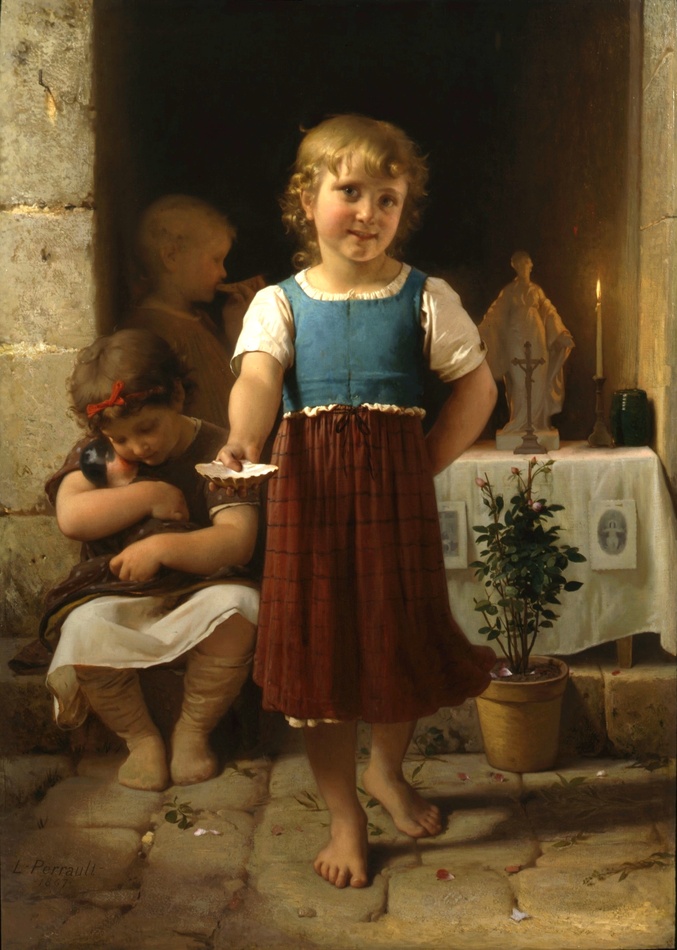Give me for my Chapel
signed and dated lower left: L Perrault 1867
Provenance:
Thomas Wigglesworth, Boston, purchased 1867
by descent
Exhibited:
Salon des Artistes Français, 1867
Boston Athenaeum, 1868
Boston Art Club, 1873
?it is not extravagant to add that no painter of children, from the time of Albano to the present day, has more perfectly rendered the inner structure and subtle modeling of surface, the peculiar quality and graceful action of a child, in perfect physical beauty and health; and all artists know that children are the most difficult of subjects. 1
Léon-Jean-Basile Perrault was a talented painter who concentrated his artistic output on the treatment of idealized, beautiful mythological and genre subjects. Inspired by his teachers, François-Édouard Picot and William-Adolphe Bouguereau, Perrault continued emphasizing the idealization and pathos found in their compositions in his own paintings.
Léon Perrault was born June 20th, 1832 in Poitiers, a town southwest of Paris. One contemporary writer described him as:
?a polished French gentleman?suave and affable in his manner, tall and vigorous, a serious worker. An extraordinarily rapid talker, his words seem to tumble over each other in their frantic haste to get out?his studio is richly and picturesquely furnished, after the usual luxurious manner of successful Parisian artists. It is, however, no place of leisure, for Perrault is one of those modern painters who do their ten hours a day of hard work. He was the air of a well-to-do, practical man of the world. 2
His earliest training was under François-Édouard Picot, but later studied under his friend William-Adolphe Bouguereau. While many highlight the fact that Perrault was a student of Bouguereau, this may have been more so on a basis of their amicable relationship, since in the majority of his Salon entries, Perrault lists Picot as his master. Perrault worked alongside Bouguereau to polish his training, while Picot was his formal teacher.
Perrault?s public career began during the period of the Second Empire, a time heavily influenced by the trauma of the 1848 social and political uprising that saw the July Monarchy and its despotic leader Louis-Philippe driven from power. In consequence, the buying public sought freedom in works that displayed a light-hearted sense of beauty, offering them some respite from the tumultuous past. Perrault?s images satisfied this public craving for delicate compositions, and not only focused on mythological scenes, but also children, nudes, genre scenes, and even military scenes.
He made his debut at the Salon of 1861 with Le Vieillard et les Trois Jeunes Hommes (The Old Man and the Three Young Men). In 1864 he was given his first recompense for his work, an honorable mention for La Frayeur (The Fright). He also earned a second-class medal in 1876 for St. Jean le Précurseur (Saint John the Precursor) and L?Oracle des Champs; -idylle (The Oracles of the Fields-Idyll).
An important element of Perrault?s work was his vision of children, which lead him to portray them with an angelic touch of softness. Whether Perrault?s young models were depicted playing a game, positioned against a background of flowers, or placed within a mythological story and setting, they all exude qualities of innocence and childish beauty. Philip Hook further explains images of childhood and their corresponding layers of meaning when he wrote, ?During the nineteenth century, popular attitudes to children crystallized into various stereotypes: innocence; the microcosm of adulthood; vulnerability; endearing naughtiness.? 3 In addition, Perrault?s focus on children, who he saw as innocent and charming, appealed to new and modern attitudes toward childhood that saw children not as miniature adults but as beings with their own characteristics.
Perrault continued to exhibit at the Salons until the end of his career. In 1887 he was named Chevalier de la Legion d?Honneur. At the Expositions Universelles of 1889 and 1900, he received a bronze and silver medal, respectively. He also exhibited in Vienna, London, Boston, and Philadelphia and won numerous medals in these exhibitions, and was later appointed, in 1873, to represent France as "Diplômât d'honneur" to Vienna, Philadelphia and London. He also became a member of the Société des Artistes Français and ?hors concours? at the Salon, allowing him to exhibit freely without the necessity of submitting work for jury acceptance. He died in 1908 in Royan. Upon his death, the town of Poitiers erected a commemorative monument in honor of his achievements.
Selected Museum Collections:
Musée des Beaux-Arts de Bordeaux; Musée Condé, Chantilly; Musée du Louvre, Paris; Musée des Beaux-Arts de Pau;
1 ?The Child in Art: Perrault?s Le Reveil d?Amour? The Century, Vol. 46 (6): pg. A2.
2 unsigned article, The Century, Vol. 46 (6) (May 1893): pg. A2
3 Philip Hook, Popular 19th Century Genre Painters: a dictionary of European genre Painters, (Woodbridge: Antique Collector?s Club, 1986): pg. 171-172.



